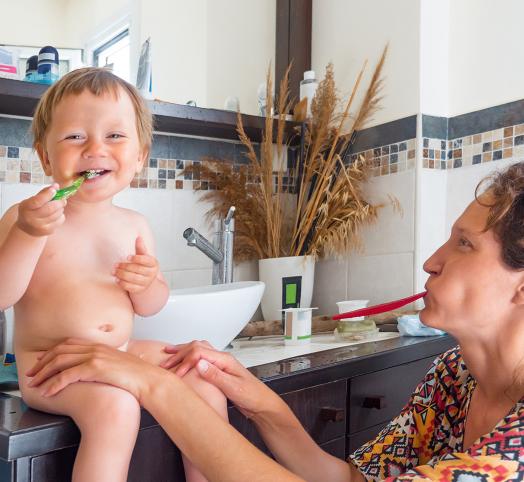Brushing your baby’s teeth for the first time
Updated on March 22, 2023
Created on July 24, 2019
Find your nearest point of sale here
Updated on March 22, 2023
Created on July 24, 2019

When should you start? A baby’s first teeth usually start to appear around the age of six months.
It’s best to get your little one into the right habit straightaway, because milk teeth get tooth decay too. Just pass a compress soaked in lukewarm water over the gums morning and night to clean the tips of their teeth.
It’s also good to get into the habit of brushing your teeth in front of your child: by showing them how you clean your teeth, they’ll soon want to copy you!
From the age of 18 months, give your child their first toothbrush and start using it with them.
From the age of two, you can add a pea-sized amount of toothpaste.
Of course, they won’t get the hang it straightaway, and they’ll probably just want to chew the brush rather than use it. Simply let them play with it, then gently finish the job yourself, if they’ll let you.
Make small circular movements with the brush, and concentrate on the area where the teeth emerge from the gums. If they refuse to let you brush their teeth, don’t insist - they risk digging their heels in! Instead, offer to help your child again the next day.
You’ll probably need to give them a hand until they are 5 or 6 years old, when they’ll be able to brush their teeth by themselves. Get them into the habit of brushing their teeth at least twice a day - once after breakfast and once before going to bed: it’s a good habit they’ll keep for the rest of their lives.
The right brush to get your child started Your baby’s gums and teeth are very delicate. To avoid irritating them, choose a small brush with soft bristles that’s specially designed for children under the age of three. There are lots of different models to choose from, often featuring their favourite characters - it’s another good way to get them brushing!
Remember to change the brush at least every three months, or more often if the bristles are worn down. When it comes to toothpaste, buy one that’s adapted to your child’s age group: they are specially formulated for children and have less fluorine than toothpastes for adults. Avoid mentholated flavours which can taste too strong for children.
Try fruit flavours like strawberry and raspberry: they’re very popular with children and they might even want to eat it. If your child swallows the toothpaste instead of spitting it out, don’t panic: it’s totally safe.
Good habits for healthy teeth Milk teeth have a thinner outer layer of enamel than adult teeth. This makes them more vulnerable to decay, which gets worse very quickly once it sets in and requires rapid treatment.
To keep teeth healthy, it’s essential to brush them regularly, but that’s only half the job. Help your child develop good eating habits by limiting the amount of sugar they consume, particularly sugary drinks.
A feeding-bottle of milk or fruit juice before bedtime is bad for the teeth, so try and wean them off it as quickly as possible.
After brushing their teeth in the evening, they should only drink water - nothing else!